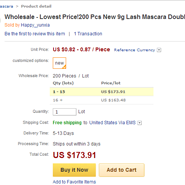- About
- Subscribe Now
- New York,
October 14, 2013

Beauty and health product counterfeiters are using cunning tactics such as infringed product and factory images and manipulated feedback ratings to dupe consumers and jeopardize brand equity, according to a new study by anti-counterfeiting and brand protection agency OpSec Security.
The study found that beyond harming brand image, counterfeiters are selling products that pose legitimate health risks to consumers. To help brands and consumers identify phony products, OpSec provides a series of telltale warning signs.
"It is important to raise awareness about the availability of counterfeit health and beauty products and the dangers these substandard products pose, but without causing alarm," said Alina Halloran, vice president of global online brand protection for OpSec Security, Boston.
"A number of luxury brands provide information about what to look for in the genuine version of their products and some of the telltale signs that a product is counterfeit," she said.
"But raising awareness cannot be left to the luxury brands alone. They need help from industry associations and governments to help stop imports and prosecute. Educating the public needs to be a collaborative effort. In the health and beauty industry, in particular, we see a lot of alarm bells being set off coming from loyal consumers who are eager to prevent others from falling prey to counterfeits."
For the "Market Study: Online Risks of Counterfeit Health & Beauty Products" OpSec used its proprietary Internet monitoring platform to identify listings of health and beauty products on business-to-business trade boards and business-to-consumer trading platforms.
Rampant listing
Perhaps the most discouraging finding is the sheer volume of counterfeiters and the massive amount of counterfeit products that are sold. The study identifies a top seller on a popular auction Web site with a listing of more than 100,000 units of a name brand shampoo.
OpSec found that more than 40,000 sellers offered brand name products and packaging in large quantities.
Counterfeit luxury products and fashion accessories have caused an estimated $26.6 billion in global financial losses, with beauty products contributing an additional $24.3 billion in 2008, according to Research and Markets, which identifies Hermes, Louis Vuitton and Tiffany & Co as brands which are menaced by counterfeiters.
Another listing offered a brand name toothpaste at six million units per month with disarmingly similar packaging to the actual product. Yet another listing offered one million units per month of a brand name mascara.
The mascara listing featured both an infringed image and negative user feedback, both of which threaten to mar brand equity.
Cologne infringement
To amplify the ordinary concerns about counterfeits, the study details dangerous chemicals such as cat urine, antifreeze and high levels of lead that have been found in counterfeit products.
Nail Polish infringement
"Any health and beauty brand or product in demand is a target," Ms. Halloran said. "This includes luxury health and beauty products, which have been counterfeited for many years and now more recently every day personal care items, such as toothpaste.
"We’ve also seen a genuine product make its way outside of authorized channels, where it’s sold after the expiration date or, worse, stored in an environment that breaks down the ingredients," she said.
"The stakes are especially high in the health and beauty industry because the product is being applied directly to the body and, in some cases, it’s being ingested."
What to do
Opsec identifies five "Suspicious Behavior Indicators" that pervade counterfeit operations.
The first sign is if a seller is able to provide massive amounts products in a short time-frame.
Second, price points that drop far below a brand's price points should warrant suspicion.
Third, an Asia-Pacific source that is willing to ship worldwide can indicate enormous quantities that lack quality control.
Another common sign is when sellers showcase manufacturing facilities that purportedly produce brand-name products.
Counterfeit claim of legitimate manufacturing facility courtesy of OpSec
Lastly, when negative comments contradict high overall rating, counterfeiters are likely to be afoot.
"There’s a host of information posted online by consumers themselves, indicating suspicious Web sites, how to spot counterfeits and other useful tips," Ms. Halloran said.
"Also, there's been a movement by the fashion and luxury industry as a whole to raise awareness through various advertising campaigns targeted to reach consumers," she said.
"We also believe that increased, integrated media coverage on this important issue and studies conducted, like those which OpSec has been publishing, are also very effective in spreading the word."
Final take
Joe McCarthy, editorial assistant on Luxury Daily, New York
Share your thoughts. Click here